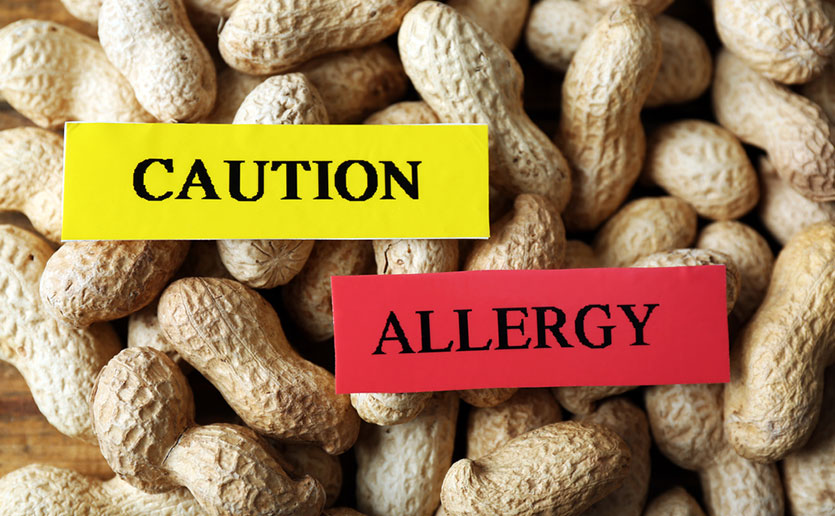Diagnosis and natural history of peanut allergy
Prevalence of peanut allergy has doubled over the last ten years
1% children \.6% adults
Peanut allergy generally persists into adulthood\
Peanut is one of the leading causes of anaphylaxis
& death from
food allergy
& death from
food allergy
How to diagnose?
1- Detailed history
*may indicate a clinically significant reaction from known peanut exposure
*will provide the basis for interpretation of diagnostic test results
*may show that the individual is at high risk
*a strongly suggestive history may be virtually diagnostic for peanut allergy
suggestive history of peanut allergy:
Timing:
The majority of reactions occur
within 20 minutes. Nearly all reactions occur
within 2 hours of exposure.
within 20 minutes. Nearly all reactions occur
within 2 hours of exposure.
Reproducibility:
Reactions should be reproducible with subsequent exposures.
Symptoms:
90% cutaneous manifestations
Non-dermatologic manifestations associated with more severe reactions:
- oropharyngeal itching
and throat tightness
- coughing
- wheezing
- nausea/vomiting
- diarrhea tacycardia
other comorbid conditions:
- Asthma
- Other allergic conditions
Atopic dermatitis
Diagnostic tests after history:
Skin Prick Testing (SPT) - the first method
In Vitro Specific IgE Testing
Oral Food Challenge (OFC) if indicated
SPT:
A positive
skin test alone
does not make the diagnosis.
skin test alone
does not make the diagnosis.
8% of the US population will have a positive SPT to peanut, but only ~1% are truly allergic
It is essential to interpret SPT test results in light of the patient history.
with a negative test : negative predictive value: 97%
The probability of peanut allergy increases with wheal size
95% positive predictive value:
wheal > or equal 8 mm
Invitro specific IgE testing :
Confirmatory in vitro specific IgE testing may be necessary after SPT
if results are equivocal or negative with a strong clinical history
if results are equivocal or negative with a strong clinical history
The probability of peanut allergy increases with higher levels of peanut-specific IgE
With a
convincing
history,
a peanut-specific
IgE > 14 kU/L
convincing
history,
a peanut-specific
IgE > 14 kU/L
has 95% p
An undetectable specific IgE level (≤0.35kU/L) does not rule out the possibility of peanut allergyositive
20% of
peanut allergic individuals have undetectable specific
IgE
peanut allergic individuals have undetectable specific
IgE
Oral food challenge
is a gold standard for diagnosis of peanut allergy
should be used if the diagnosis is uncertain after history, SPT, IgE
should also be used to confirm resolution of allergy
OFC should always be physician-supervised in a facility equipped to handle anaphylaxis.
Quality of life often improves after OFC even if a patient fails the challenge
Risk factors for persistent peanut allergy:
Larger wheal size at initial diagnosis
Increasing wheal size during the first years after initial diagnosis
Higher levels of peanut-specific IgE at the time of diagnosis
Increasing levels of peanut-specific IgE over timedictive value
severe reactions: GI manifestations, anaphylaxis
concurrent atopic conditions:,atopic rhinitis
additional nut allergies
30% of peanut allergic are allergic also to tree nuts
spontaneous resolution of peanut allergy:
20% of allergic children will tolerate peanut by age 8 years
children with peanut allergy should be periodically evaluated for resolution
there is a greater likelihood for resolution of allergy for children: with small wheal size and/or low levels of peanut-specific IgE at the time of diagnosis and who continue to have low levels in subsequent years.
those children should be evaluated regularly
If there is a
significant likelihood
that a child has outgrown peanut allergy,
significant likelihood
that a child has outgrown peanut allergy,
a physician-
supervised OFC
should be
pursued.
supervised OFC
should be
pursued.
Risk factors for recurrence:
can recur in 8% of the individulas
Patients who have passed an OFC should still consider carrying an epinephrine auto-injector in the event of recurrence.
the risk for recurrence is greater in children who continue to avoid peanut after resolution of allergy
children who have passed OFC should keep peanut in their diet








No comments:
Post a Comment